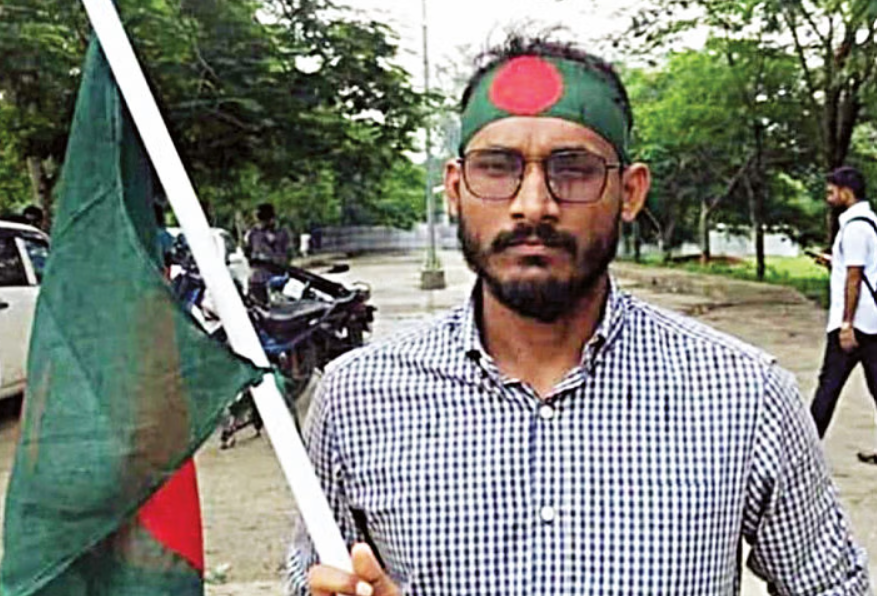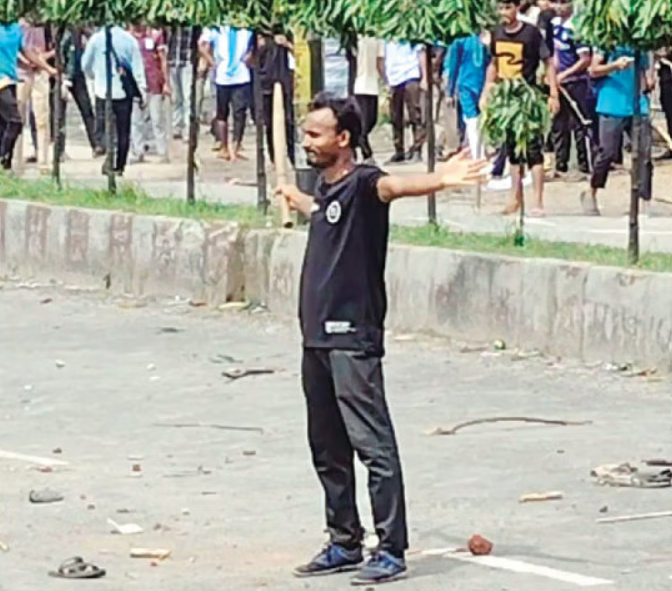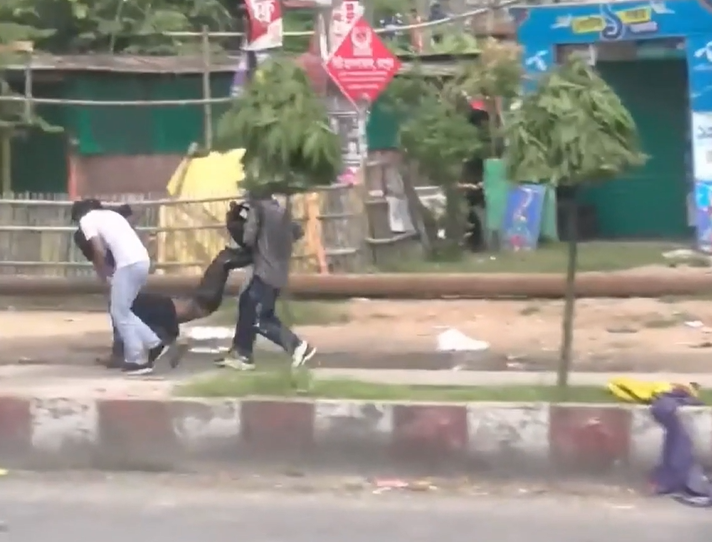
The month of July 2024 deserves a unique status in the history of the democratic movement of Bangladesh. Blood has been shed repeatedly in this month, the palace of the ruler has been shaken by the calls of students, workers, and the public. That turbulent July began with the blood of a student named Abu Sayeed, who stained the soil of Begum Rokeya University, and was shot in the chest by the bullets of the police in Rangpur. He lies silently, in a bamboo-fenced grave in a village called Babanpur, Pirganj.
He is the first martyr of the July Revolution. His death was not just a loss of life, but it was a naked manifestation of state oppression and the starting point of a new phase of student politics. Due to the mismanagement of the state machinery, recruitment and trade, political occupation, and devaluation, this new university has repeatedly become a volcano of anger. When students across the country started a peaceful movement demanding quota reforms in jobs and securing their future, the explosion of July 2024 took place here too. But the peaceful program was answered by the brutal firing of rifles by the extremist police. After the death of this martyred student, a wave of rebellion rose in universities across the country.
Personal life: Abu Sayeed was born in 2001 in Babanpur village of Pirganj Upazila of Rangpur district. His father’s name is Maqbul Hossain, and his mother’s name is Monowara Begum. Abu Sayeed is the youngest of six brothers and three sisters, nine siblings. He passed the fifth grade at the local Jafar Para Government Primary School after receiving a scholarship in the talent pool. Then he passed the SSC from the local Khalashpir Dwimukhi High School with a golden GPA of 5. Then he passed the HSC from Rangpur Government College in 2018 with a GPA of 5. Later, he joined the English Department of Begum Rokeya University in 2020. He was a 12th-batch student of the English Department of Rokeya University.
Last post on social media of Sayed, who was shot dead by police:
Abu Sayed, a 12th batch student of the English Department of Begum Rokeya University, was shot dead by police during the ongoing movement demanding quota reform in government jobs in Bangladesh. A day before his death, on July 15, Abu Sayed posted a post on social media on Facebook, regretting the non-participation of teachers in the ongoing movement. After his death, it has now gone viral on social media. On February 18, 1969, before the independence of Bangladesh, Syed Mohammad Shamsuzzoha, an associate professor (then reader) of the Chemistry Department of Rajshahi University, was martyred while protecting university students from the attack of the Pakistani army during the movement against the then Pakistani ruler Ayub Khan. This teacher also said at a meeting of university teachers on February 17, the day before his death – “Today I am stained with the blood of my students. If any bullets hit the students, I want them to hit me instead.” Shamsujoha posted this statement on Facebook and wrote to Abu Saeed the day before his death – “Sir! At this moment, Sir, we need you very much! Everyone who was in your contemporary time is dead, but you are immortal even after death. Your tomb is our inspiration. We are illuminated by your consciousness. Those of you who are in this generation will also die one day, according to the laws of nature. But as long as you are alive, live with a backbone. Support the just demands, take to the streets, and stand as a shield for the students. You will receive true respect and admiration. Do not disappear into the womb of time immediately after death. You will live today as Shamsujoha. “It is much more joy, honor, and pride to see at least one ‘Shamsujoha’ die.” Perhaps inspired by his post, teachers of various universities, colleges, schools, and madrasas joined the students’ movement and came forward to save their lives.
From 12 noon on July 16, quota activists were protesting in the Rokeya University area. A video of the entire incident of Abu Saeed being killed in police firing was broadcast in the Bangladeshi media. In that video, it is seen that between 2:30 and 3 pm, a clash broke out

between the protesting students and the police in front of Rokeya University. When the clash with the police started, Abu Saeed was in front of everyone. While the police were firing rubber bullets at the protesters, the other protesters retreated, but Abu Saeed stood with a stick in his hand and kept shouting slogans. At this time, the police shot at him from right in front. Abu Saeed was seen trying to block the rubber bullets of the police with the stick in his hand. But several of the rubber bullets continuously fired by the police were. The video also shows that Abu Sayeed, after being hit in the body, retreated at one point. He sat down on the sidewalk.

Then, some protesters ran from behind and grabbed his hands and feet. Anjan Roy, a friend of the deceased Abu Sayeed, told local media, “Abu Sayeed fell to the ground after being injured by rubber bullets one after another. Blood was pouring from his nose. At that time, the clash was going on. There was a delay in taking him to the hospital.” Hridoy Ranjan Roy, head of the surgery department of Rangpur Medical College Hospital, said, “He died before being admitted to the surgery ward of the medical college. However, there are rubber bullet wounds in several places on his body. Blood was pouring from his nose. But whether he died from a rubber bullet or not, it is not possible to say at this time without the autopsy report.”
Janaza (Funeral prayer) of Abu Sayeed:
His janaza was held at Jafarpara Madrasa ground in Babanpur village of Madankhali union of Pirganj upazila on Wednesday, July 17, at 9 am. It was attended by a large crowd. Later, Abu Sayeed was laid to rest in the family graveyard. Abu Sayeed’s relative, Md. Siam Mia led the funeral prayer. Abu Sayeed’s body reached his village around 2 am on Tuesday. When the body reached the village, a heartbreaking scene unfolded there. The atmosphere in the area became heavy with grief and tears. Hundreds of people were waiting there. Locals said that Abu Sayeed was very talented, protesting, honest, and brave. It is worth noting that on Wednesday (July 17), the absentee janaza of 6 people killed in the quota reform movement was held at Dhaka University (DU). At that time, to continue the movement by touching the coffin, the protesters took the oath. The Students’ Movement Against Discrimination has announced a ‘complete shutdown’ program across the country on Thursday (July 18), demanding a one-point demand: to protest against the attacks by law enforcement agencies on the peaceful movement of students, to ensure a campus free of terror.
Case:
Mysterious but true, on July 17, the day after Abu Sayeed’s death, Tajhat Police Station Sub-Inspector and Begum Rokeya University Police Outpost In-charge Bibhuti Bhushan Roy filed a case at Tajhat Police Station. The initial information report of the case blamed the protesters for Abu Sayeed’s death. If the administration’s people are so brazen and liars, the police have mentioned such lies in the information report of the case
“A student was seen lying on the road at one stage during the firing and brickbatting by the protesters from different directions. His classmates caught him and took him to Rangpur Medical College Hospital, where the doctor on duty declared him dead.”
As millions of people can clearly see in the video, Abu Sayeed throws down the stick in his hand and gives it to the police, spreading his arms while the police shoot him dead from very close range with several rounds. The autocratic police could have easily arrested him without shooting him and could have brought him to justice under the law. Then he would not have had to say goodbye forever.
Reaction:
Dr. Muhammad Yunus about Abu Sayeed:
Chief advisor to the interim government, Dr. Muhammad Yunus, said, This is Abu Sayeed’s Bangladesh. There is no discrimination in Abu Sayeed’s Bangladesh. So, wherever Abu Sayeed’s parents, siblings, or whoever is there, protect them. Don’t let any trouble happen. So that no one else dies like Abu Sayeed. He told these things to journalists after visiting Abu Sayeed’s grave in Babanpara village of Pirganj upazila of Rangpur and talking to his family members. Dr. Muhammad Yunus also said The way Abu Sayeed stood against injustice, we too have to stand in the same way. Abu Sayeed is now in every home. Everyone’s child, regardless of race or religion. This Abu Sayeed is the child of every Hindu-Muslim, Christian-Buddhist family here. So, please take care that there is no trouble anywhere. No one should talk about religion. Because we are the children of this land, all of us are Abu Sayeed. All the families in Bangladesh are the children of all families. Students will read about Abu Sayeed in school. They will understand for themselves that I will also fight for justice, and I will also give them a chest. Interim Head of Government Dr. Yunus said we must protect the children of this land regardless of race or religion. We should ensure this. We also have to stand the way Abu Sayeed stood. Those who differentiate, such children and such children, not like that. We are all Bangladeshis; we are the children of Bangladesh. Abu Sayeed’s mother is everyone’s mother, and everyone’s mother is Abu Sayeed’s mother. Therefore, we have to protect them, protect their sisters, protect their brothers. We all have to do this together.
After the grave visit, Chief Advisor Dr. Muhammad Yunus went to Abu Sayeed’s house. Abu Sayeed’s father, Maqbul Hossain, broke down in tears upon seeing the Chief Advisor. He sat in the courtyard of Abu Saeed’s house for some time and talked to his parents and family members, and consoled them. The Chief Advisor, along with Abu Saeed’s parents, stood in the courtyard of their house and raised the national flag. Later, he handed over the national flag to Saeed’s family and said, “Abu Saeed gave his life for this flag. Keep this flag properly.” At this time, he assured the family that Abu Saeed’s murder would be brought to justice. At this time, thousands of people gathered on both sides of the road in Pirganj to welcome the Chief Advisor. Regarding Abu Saeed, he said, “We read epics. Epics will be written about Abu Saeed. Abu Saeed is the hero of the epics. In the future, poems, stories, and literature will be written about him. The picture of him being shot that people saw. After this, people could not be stopped anymore. Abu Saeed shocked the world.
Speaking about Abu Sayeed’s death, Farooq Faisal, executive director of the Law and Arbitration Center, told BBC Bangla, “Since the boy did not have any lethal weapon, there was no need for the police to be violent, but instead, the police opened fire. Such an attack on innocent people is completely unacceptable.” On July 17, Indian actress Swastika Mukherjee posted a picture of Abu Sayeed on Facebook and wrote, “Today, I feel restless. I am also a mother of a child. I hope Bangladesh will be peaceful.” On July 26, the administration of Begum Rokeya University provided financial assistance to Abu Sayeed’s family. Will this assistance be able to meet Abu Sayeed’s needs?
Rangpur Park intersection renamed:
Students renamed the park intersection ‘Abu Sayeed Chattar’ In memory of Abu Sayeed, a member of the Coordination Committee of the Quota Reform Movement and a student of Begum Rokeya University (Berobi), who was shot dead by the police, the students demanded that the name of Rangpur Park intersection be changed to ‘Shaheed Abu Sayeed Chattar’. In the end, it was done. Ordinary students made this demand on their profiles, various pages, and groups through social media. Currently, the name ‘Shaheed Abu Sayeed Chattar’ is visible in place of the park intersection on Google Maps. A person from Berobi named Obaidur Rahman wrote in a Facebook group, ‘Already, the name of the park intersection on Google Maps has been changed to Shaheed Abu Sayeed Chattar. Will you honor him by calling this square after him or by another name? Another student wrote in a Facebook post, ‘From today, Rangpur Park. The name of the intersection is Shaheed Abu Sayeed Chattar – Ordinary Students.’
Abu Sayeed in the colors of ‘India’s Artist’:
The ‘complete shutdown’ program of the quota reform activists is going on. Due to this, 229 platoons of BGB have been deployed across the country, including Dhaka. In this situation, the Facebook timeline of the stars does not stop. Many stars from the showbiz arena to the media community have become active. Popular theater director Mabrur Rashid Bannah has posted a drawing of the student Abu Sayeed, who was killed in police firing, on social media. He wrote in the caption of the picture, ‘This picture of the brave martyr Abu Sayeed has been drawn by the Indian artist Kaushik Sarkar.’
Abu Sayeed’s father has requested that, instead of building sculptures or portraits of his son, the first martyred student of the quota reform movement, do something for the welfare of the people. Abu Saeed’s father, Maqbool. In a letter signed by Abu Saeed’s elder brother Ramzan on behalf of his father, he said, “We have come to know through Facebook that some people have taken the initiative to build a sculpture or portrait of Abu Saeed. I respectfully request that everyone, if you want to do something for your son, do something that is in the interest of the people.”
Written by Taharul Kaiser ^ 6th July 2025 ^ dekonamake@gmail.com
